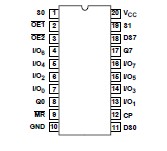CD54HCT299: Features: • Buffered Inputs• Four Operating Modes: Shift Left, Shift Right, Load and Store• Can be Cascaded for N-Bit Word Lengths• I/O0 - I/O7 Bus Drive Capability and Three...
floor Price/Ceiling Price
- Part Number:
- CD54HCT299
- Supply Ability:
- 5000
Price Break
- Qty
- 1~5000
- Unit Price
- Negotiable
- Processing time
- 15 Days
SeekIC Buyer Protection PLUS - newly updated for 2013!
- Escrow Protection.
- Guaranteed refunds.
- Secure payments.
- Learn more >>
Month Sales
268 Transactions
Payment Methods
All payment methods are secure and covered by SeekIC Buyer Protection PLUS.

 CD54HCT299 Data Sheet
CD54HCT299 Data Sheet







